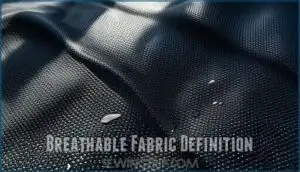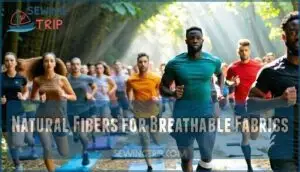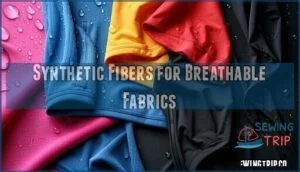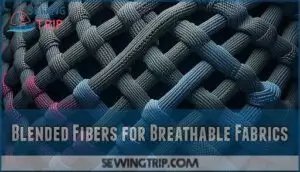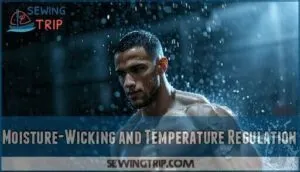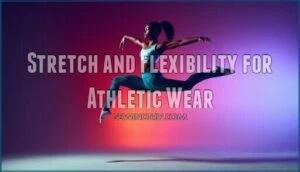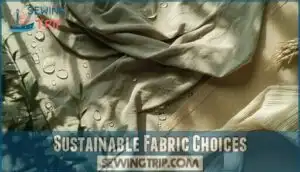This site is supported by our readers. We may earn a commission, at no cost to you, if you purchase through links.
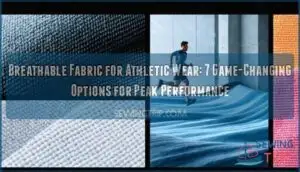 When choosing breathable fabric for athletic wear, you’ll want materials that efficiently transport sweat away from your skin.
When choosing breathable fabric for athletic wear, you’ll want materials that efficiently transport sweat away from your skin.
Moisture-wicking synthetics like polyester and nylon offer excellent durability, while natural options such as merino wool provide odor resistance.
Modern technical fabrics blend these fibers with elastane for stretch that moves with you.
The right fabric works like your personal cooling system—pulling moisture to the outer surface where it can evaporate.
Unlike cotton, which becomes a soggy burden during intense workouts, performance fabrics keep you dry and comfortable.
Understanding fabric technology can be the difference between powering through your workout and feeling like you’re exercising in a sauna.
Table Of Contents
Key Takeaways
- You’ll want moisture-wicking synthetics like polyester and nylon for durability, or natural fibers like merino wool for odor resistance—unlike cotton which becomes heavy when wet, these fabrics pull sweat away from your skin and allow it to evaporate.
- Your athletic wear’s performance depends on its breathability—fabrics with specialized weave structures enhance ventilation and maintain thermal resistance, keeping you cool during intense workouts.
- You can choose from various options including natural fibers (cotton, bamboo, hemp), synthetics (polyester, nylon, spandex), or blended fabrics that combine the benefits of multiple materials for customized comfort and performance.
- You’ll extend your breathable athletic wear’s lifespan by washing in cold water with mild detergents, avoiding fabric softeners, and air-drying instead of using high heat—while also reducing your environmental footprint.
Breathable Fabric Definition
Breathable fabric allows air and moisture to pass through its fibers, helping you stay cool and dry during intense workouts.
You’ll find this essential performance feature in both natural materials like cotton and wool, as well as synthetic options like polyester and nylon that actively wick sweat away from your skin.
Characteristics of Breathable Fabrics
Designed for peak performance, breathable fabrics feature specific characteristics that set them apart from regular textiles.
Their fabric air permeability allows sweat vapor to escape while maintaining thermal resistance. You’ll notice these performance fabrics have specialized weave structures that enhance ventilation.
Fiber properties contribute to moisture management capabilities, making breathable athletic wear comfortable during intense activities. The best moisture-wicking fabrics balance quick-drying functionality with comfort, preventing that clammy feeling you’ve grown to hate.
Some fabrics also utilize open knit weaves to maximize airflow.
Types of Breathable Fabrics
Several types of breathable fabrics dominate the athletic wear landscape today.
From lightweight polyester and moisture-wicking nylon to specialized fiber blends, your options vary by fabric construction and weave patterns.
Each fabric weight offers different benefits—mesh for maximum airflow, microfiber for softness, and technical knits for durability.
Finish types like antimicrobial treatments add functionality, while different fabric weights suit specific activities.
You’ll find everything from featherlight racing materials to medium-weight training fabrics.
Benefits of Breathable Fabrics for Athletic Wear
During intense workouts, breathable fabrics offer you substantial performance enhancement benefits.
Breathable fabrics elevate your workouts, keeping you cool, dry, and comfortable, so you can push limits without distractions.
They regulate your body temperature, preventing overheating while wicking moisture away from skin.
This technology improves comfort levels and minimizes chafing.
Performance apparel with breathable workout clothes also provides excellent odor control through antimicrobial properties.
The versatility of these fabrics guarantees your athletic wear maintains skin health and adapts to various activity levels and environmental conditions, ensuring overall comfort levels and skin health.
Fabric Types and Options
You’ll find a range of fabric options for athletic wear, from natural fibers like cotton and bamboo to synthetic materials such as polyester and nylon, each offering unique breathability benefits.
Your choice impacts both comfort during workouts and performance factors like moisture-wicking and temperature regulation, making it essential to understand the specific properties of each material, including their effects on overall comfort.
Natural Fibers for Breathable Fabrics
In the context of natural fibers for breathable fabrics in athletic wear, you’ll discover options that work with your body, not against it.
Natural fibers provide excellent moisture management while maintaining comfort.
- Cotton offers exceptional absorbency, holding 25-27 times its weight in water
- Bamboo delivers antimicrobial properties and blocks 98% of harmful UV rays
- Linen’s durability makes it quick-drying and lightweight for active pursuits
- Hemp benefits include hypoallergenic qualities and lasting up to two decades
For a wide selection, consider browsing cotton athletic wear.
Synthetic Fibers for Breathable Fabrics
While natural fibers offer excellent breathability, synthetic options have revolutionized athletic wear.
Modern polyester, nylon, and spandex provide exceptional performance benefits through advanced construction methods.
| Synthetic Fiber | Key Benefit | Best For |
|---|---|---|
| Polyester | Quick-drying | All-season training |
| Nylon | Durability | High-impact sports |
| Spandex | Stretch | Yoga, gymnastics |
| Microfiber | Softness | Sensitive skin |
| Synthetic Blends | Versatility | Daily workouts |
You’ll find these moisture-wicking fabrics maintain breathability despite their petroleum origins—fabric construction matters more than fiber type alone.
Many athletes now prefer polyester based apparel for its comfort.
Blended Fibers for Breathable Fabrics
Blended fibers bring the best of multiple materials, creating breathable fabric for activewear.
These combinations combine polyester’s durability, nylon’s smoothness, and spandex’s stretch. You get customized comfort and performance in one fabric.
- Fiber Combinations: Mix strength and breathability seamlessly.
- Blend Performance: Balance flexibility and resilience.
- Weave Structures: Boost airflow and fit.
- Fabric Weight: Perfectly balanced for movement.
- Cost Analysis: Quality without breaking the bank.
Performance and Style Benefits
You’ll experience both peak athletic function and stylish appeal with today’s breathable athletic fabrics that regulate your body temperature while wicking away moisture.
These performance textiles don’t just enhance your workout efficiency through flexible, durable construction—they’re also designed with fashionable patterns and colors that shift seamlessly from gym sessions to casual outings, providing breathable athletic wear that combines athletic function with style.
Moisture-Wicking and Temperature Regulation
During intense workouts, your body’s temperature regulation depends heavily on fabric breathability.
Quality moisture-wicking fabrics pull sweat away from your skin, accelerating evaporation and cooling you down.
These temperature-regulating materials adapt to different climates—keeping you warm in cold conditions and cool in heat.
This moisture management system isn’t just about comfort; it’s a performance enhancement tool that helps maintain ideal body temperature when you’re pushing your athletic limits.
Stretch and Flexibility for Athletic Wear
While proper temperature control keeps you comfortable, freedom of movement is equally important.
Stretchy fabrics with high elasticity allow your body to move naturally during workouts. The best athletic fabrics offer 4-way stretch and excellent recovery benefits, preventing sagging after repeated use.
Fabric stretchability enhances performance by enabling full range of motion while body contouring properties provide support where you need it most. No more feeling restricted by your gear, and enjoying the full range of motion is key to a great workout experience.
Fashionable and Chic Designs for Athleisure
Athleisure aesthetics have revolutionized how we approach workout wear, blending comfort focus with style versatility.
You’re no longer limited to basic gym attire when you can showcase your personality through trendy activewear.
The choice of fabric substantially impacts the overall garment aesthetics.
- Customization options let you choose from vibrant color trends or timeless neutrals
- Layering pieces create multi-dimensional, fashionforward looks
- Accessories elevate basic activewear into stylish statement outfits
- Chic styles shift seamlessly from workout to casual settings, providing style versatility and a personalized approach.
Care and Maintenance Tips
Taking care of your breathable athletic wear doesn’t have to be complicated, but it does require a bit of attention.
With the right washing, drying, and handling techniques, you can keep your gear performing its best while lasting longer.
Washing and Drying Instructions
Your high-performance athletic wear deserves proper care to maintain its breathability and function.
Proper fabric maintenance starts with understanding the right washing and drying techniques.
| Fabric Type | Water Temperature | Detergent Selection | Drying Methods |
|---|---|---|---|
| Polyester | Cold | Mild, no fabric softeners | Tumble dry low |
| Cotton blends | Warm | Sport-specific | Air dry |
| Nylon | Cold | Gentle | Hang to dry |
| Technical fabrics | Cold | Specialized | Lay flat |
Always check garment labels for specific instructions. Most machine washable fabrics respond well to gentle cycles, while quick-drying fabrics need minimal heat exposure.
Selecting color safe detergents can also help maintain the vibrancy of your athletic wear.
Ironing and Handling Precautions
Now that you know how to wash your athletic wear, let’s talk about handling them after.
Keep ironing temperatures low to prevent heat damage to synthetic fabrics. Many performance materials don’t need ironing at all—just smooth them while damp and hang to dry.
If wrinkles appear, opt for steaming options instead.
Proper storage methods (hanging or loose folding) prevent fabric distortion and maintain elasticity longer than cramming them in drawers.
Environmental Impact of Fabric Care
While proper ironing techniques protect your athletic wear, your fabric care routine also impacts the planet.
Your washing and drying habits contribute substantially to your environmental footprint.
- Using biodegradable detergents reduces harmful chemicals entering waterways
- Air drying athletic wear saves 75% energy compared to machine drying
- Cold water washing decreases energy consumption by up to 90%
- Microfiber catching laundry bags prevent microplastic pollution in oceans
Choose eco-friendly fabric care methods to keep both your performance gear and the environment in top shape.
Sustainable Fabric Choices
You’ll make a significant impact on the planet while breaking a sweat in sustainable athletic fabrics made from bamboo, hemp, and lyocell.
These eco-conscious materials don’t just reduce your carbon footprint—they offer superior breathability, moisture-wicking properties, and durability that rival conventional synthetic options.
Eco-Friendly Fabric Options for Athletic Wear
Now that you know how to care for your athletic wear, let’s look at eco-friendly fabric options that won’t cost the planet.
| Fabric | Environmental Benefit | Performance | Durability |
|---|---|---|---|
| Recycled Polyester | Made from plastic bottles | Excellent moisture-wicking | Highly durable |
| Organic Cotton | No harmful pesticides | Breathable & hypoallergenic | Moderate wear |
| Bamboo | 35% more oxygen release | Temperature regulating | Long-lasting |
| Hemp | Minimal water usage | Naturally antibacterial | Can last decades |
You can also find a variety of sustainable sportswear options online. These sustainable textiles offer the performance you need without the environmental footprint, making them a great choice for those looking for environmentally friendly and durable athletic wear.
Recyclable and Biodegradable Fabric Materials
While making eco-friendly choices in athletic wear, you’ll want materials that don’t just perform well but also return to the earth when their usefulness ends.
Today’s biodegradable synthetics and recycled polyester options are changing the game.
Companies like HBF Textiles now produce recycled polyester fabrics that are 91-93% biodegradable.
Look for fabric certifications or materials made in closed-loop systems like ECONYL (recycled nylon from fishing nets) or Tencel (lyocell) for truly sustainable textiles.
Reduced Environmental Footprint Through Fabric Selection
Your fabric choices matter for the planet’s health. By selecting eco-friendly fibers like recycled materials and biodegradable options, you’ll reduce your environmental footprint substantially.
Sustainable sourcing practices guarantee the entire fabric lifecycle minimizes waste. Consider fabrics made from recycled plastic bottles or regenerated nylon that divert waste from landfills.
One great option is organic pesticide-free cotton, which supports soil health. Fabric sustainability isn’t just trendy—it’s necessary for preserving resources and protecting ecosystems for future generations, making environmental footprint a crucial consideration.
Frequently Asked Questions (FAQs)
What is the most breathable fabric for activewear?
While synthetic fabrics wick sweat away, natural cotton breathes easier against your skin.
For activewear, you’ll find moisture-wicking polyester blends or lightweight mesh as your best options, with bamboo offering exceptional breathability and antimicrobial properties.
What is the best fabric for athletic wear?
Polyester-spandex blends offer you the ideal balance of moisture-wicking, stretch, and durability for athletic wear.
Cotton, while comfortable, isn’t recommended as it retains sweat.
Performance fabrics with antimicrobial properties are worth the investment.
What is the best fabric for hot weather sports?
Let your skin breathe like a cooling breeze in hot weather sports.
You’ll want lightweight polyester or mesh fabrics that wick moisture away from your body while allowing maximum airflow and evaporation.
What material is breathable for a gym?
You’ll want moisture-wicking fabrics like polyester, nylon, or specialized blends for gym workouts.
These materials pull sweat away from your skin, keeping you dry and comfortable while allowing proper airflow during exercise.
How long do breathable fabrics last?
You’ll enjoy years of performance with quality breathable fabrics.
Hemp can last up to two decades, while polyester and nylon typically serve you well for 2-5 years with proper care and regular washing.
Are breathable fabrics suitable for extreme weather?
Yes, breathable fabrics can handle extreme weather effectively.
You’ll find they’re designed to regulate your body temperature – wicking moisture in hot conditions while providing insulation in cold environments when properly layered.
Can breathable fabrics cause skin irritation?
While some may walk on eggshells around certain fabrics, you’re rarely at risk with breathable athletic materials.
Synthetic options might irritate sensitive skin, but natural fibers like cotton usually won’t cause problems.
Which certifications indicate quality breathable fabrics?
Look for Berry Compliant, ROHS & REACH certifications when shopping for quality breathable fabrics.
These standards guarantee your athletic wear meets environmental and safety regulations while delivering superior performance for your workouts, ensuring you get the best out of your workouts.
Do breathable fabrics protect against UV rays?
Bamboo fabrics block 98% of harmful UV rays, offering substantial sun protection during your workouts.
Many breathable athletic fabrics include UV protection, but it varies by material.
You’ll find natural options like wool particularly effective, and UV protection is a key consideration for many athletes.
Conclusion
Like a second skin that breathes with you, the right breathable fabric for athletic wear transforms your performance.
Whether you choose moisture-wicking synthetics, odor-resistant merino wool, or cutting-edge blends, you’re investing in comfort and performance.
Don’t let sweat hold you back. By selecting fabrics engineered for ventilation and moisture management, you’ll stay cool, dry, and focused on crushing your goals—not on your soggy clothes.
Your workout gear should work as hard as you do, and with the right fabric, you can ensure that you’re comfortable and performing at your best.

